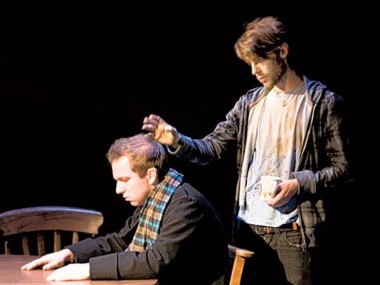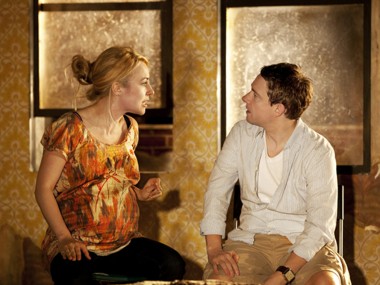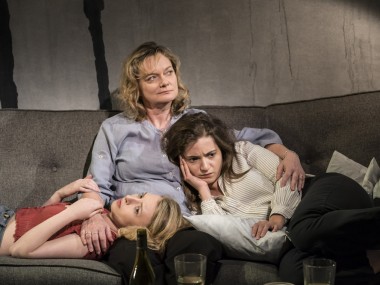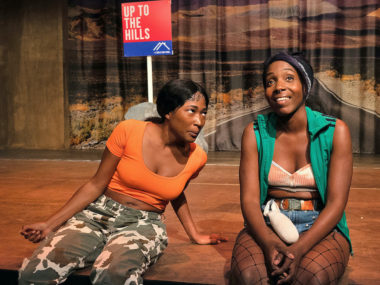A Good House, Royal Court
Friday 17th January 2025
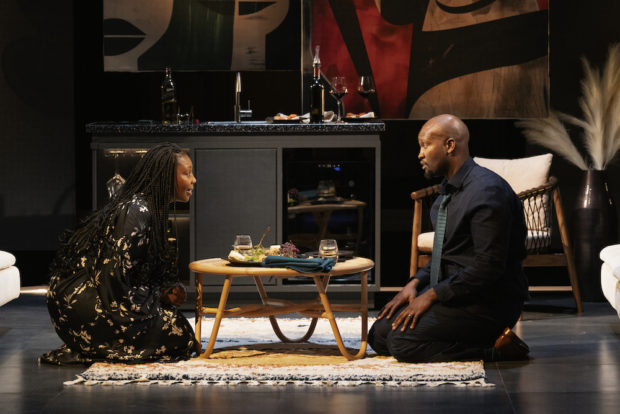
Most Brits don’t know much about South Africa today, but we do know lots about house values, so this new comedy by South African playwright and screenwriter Amy Jephta is comprehensible — even in its incoherent moments (of which there are several). Grabbing the chance to expand his venue’s horizons internationally, David Byrne — Royal Court artistic director — has chosen A Good House, billed as an “explosive exploration of race, resentment and community politics”. Marketing hype aside, this 100-minute single-act drama was originally commissioned as a co-production with the Fugard Theatre of Cape Town, which closed down a couple of years ago, and is now a co-production with the Market Theatre in Johannesburg and the Bristol Old Vic, where it will visit next month after its rather short London run.
Set in Stillwater, a classy South African suburb which could in fact be anywhere, the plot is simple: when a shack appears on a vacant lot in one of the streets, the middle-class residents have to decide how to deal with the squatters. A wealthy black couple, Sihle and Bonolo, are approached by a middle-aged white couple, Christopher and Lynette, who want them to be the acceptable face of a bid to evict the impoverished shack dwellers, assumed by everyone to be black. A younger white couple, Andrew and Jess, have recently paid more than they can actually afford to buy their house, and live right next to the shack, which seems like a direct threat to the insecure Andrew.
Jephta’s play is an odd, maybe deliberately disconcerting, mixture of the comic and the serious, with rapid shifts of tone, from naturalism to the surreal. Her characterisation is likewise a mix of realism and stereotype: the most convincing characters are Sihle and Bonolo. He is a bigshot financier, who was raised in a shack and has climbed his way up the professional ladder, using a smiley charm and compulsive bonhomie while arming himself against the prejudices of his colleagues, who call him Slinky. By contrast, his wife is bourgeois “as fuck”, and never visits any of her poorer family. But she is more openly alert to racist slights and will call out anyone who makes assumptions based on skin colour. Some of the best passages in the play show how she mocks her husband’s desire to please the white folks, while he responds by pointing out that he was her first black boyfriend.
The white characters — especially the men — are, for comedy’s sake, more clumsily prejudiced and more stereotypical in their reactions to the appearance of the shack. Businessman Christopher and Andrew, who is a not very successful sandwich shop manager, get the most laughs because of their awkward missteps in dealing with black people, with some sharply excruciating moments as their unconscious racism is exposed. Lynette, the local estate agent, knows the monetary price and social value of the neighbourhood’s properties, while Jess, a yoga teacher working from home is the most underdeveloped character.
The plot involves a handful of meetings during the course of which Christopher sets up a local residents association, recruiting Sihle and Bonolo as token blacks so that this couple can head up the plan to evict the squatters. These moves raise tensions not only between the three couples — with Sihle wondering aloud how Andrew and Jess could afford to live in this exclusive area — but also within each couple. Bonolo becomes exasperated at her husband’s eagerness to please, while he points out her hypocrisies; Lynette and Jess desperately try to cover up the clumsy racism and micro-aggressions of their partners. It’s fun, but what does it all mean?
The central theme of A Good House is indicated by its title: what, Jephta asks, is a good house? Does this depend on its cost, its location, or the contentment of its inhabitants? And, further, who belongs and who doesn’t in an exclusive enclave? She clearly shows how Stillwater’s residents have made sacrifices to live where they do, but also how they are very insecure and unstable, regardless of race. At the same time, and rather obviously, the racism of the whites — mocked by the blacks — is shown to be revoltingly ridiculous. But, it must be said, this is an easy target, and a more interesting play would have explored Sihle and Bonolo’s lives at greater depth.
The play’s action is more than once interrupted as lights change and Sihle and Bonolo invite us into their thoughts, subjective and a bit surreal, to comment on the attitudes of the whites. These are great moments, but they add to a general sense of incoherence, as if the play can’t decide whether it is about ideas or people. Still, there is a lot of enjoyably satirical material: we are encouraged to mock Bonolo’s pretentious admiration of her wine aerator and special cheese knife; Jess’s cake is a farcical prop; and laughter is used to defuse social tensions. Sihle occasionally talks to Bonolo in Zulu, a language she doesn’t understand.
Of course, the shack itself is a central character in A Good House. It appears almost miraculously, and its inhabitants are invisible — no one ever sees them, but everyone is anxious about them. They are perceived as an infestation: if the residents of Stillwater do not get rid of this one shack, other shacks and other squatters will soon arrive. They will be black, and poor. The invisibility of the shack’s inhabitants is a beautifully absurdist touch, and there’s a great moment when it suddenly grows an upward extension, and new windows and even a satellite dish. It has a life of its very own.
Directed by Nancy Medina, artistic director of the Bristol Old Vic, this production is colourfully designed by ULTZ, but could have been more pacy. The joke about Bonolo’s wine aerator goes on too long, and the acting swings a bit uncertainly between loud farce and a more subtle realism. Mimî M Khayisa and Sifiso Mazibuko are the most memorable as Bonolo and Sihle, and are well supported by Scott Sparrow and Olivia Darnley as Christopher and Lynette. Robyn Rainsford is amusing as the New Age Jess and Kai Luke Brummer likewise as the nervy Andrew. A Good House is perceptive and provocative, but it’s also an imperfect mix of styles and topics.
This review first appeared on The Theatre Times

